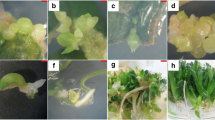Abstract
Somatic embryogenesis (SE) is a widely used method in grape (Vitis vinifera) biotechnology as it permits the rapid multiplication of clonal material from a single explant source. A commonly observed difficulty with this technique, however, is that many of the newly derived embryos either cease development entirely or they develop abnormally and fail to form a plantlet capable of survival beyond the in vitro environment. Previous studies have reported that somatic embryos of grape enter into a state of endodormancy similar to that seen in grape seeds. Grape seeds require a cold period of several weeks to induce germination and the release of the embryo from dormancy is associated with a rapid rise in endogenous gibberellins. We tested the influence of cold and/or a pulse treatment of gibberellic acid (GA3) on embryogenic callus cultures of the variety Pinot noir. In the most efficient treatment tested (8 weeks in cold), a 4.6-fold improvement in plantlet recovery was recorded compared with that in the untreated controls. The improvement in yield was the result of combined increases in embryo differentiation and embryo germination. Treatment with GA3 improved embryo germination compared to the untreated controls, but only when GA3 was used in combination with sub-optimal cold treatments. The GA3 pulse treatments tested had no measurable impact on embryo differentiation or on the differentiation of plantlets from young germinated embryos.






Similar content being viewed by others
Abbreviations
- 2,4-D:
-
2,4-Dichlorophenoxyacetic acid
- ABA:
-
Abscisic acid
- BAP:
-
6-Benzylaminopur
- EC:
-
Embryogenic callus
- GA3 :
-
Gibberellic acid, GA3
- IE:
-
Immature embryos
- MS:
-
Murashige and Skoog basal medium
- SE:
-
Somatic embryogenesis
References
Boss PK, Thomas MR (2002) Association of dwarfism and floral induction with a grape ‘green revolution’ mutation. Nature 416(6883):847–850
Faure O, Dewitte W, Nougarède A, Van Onckelen H (1998) Precociously germinating somatic embryos of Vitis vinifera have lower ABA and IAA levels than their germinating zygotic counterparts. Physiol Plantarum 102(4):591–595
Flemion F (1937) After-ripening at 5 C favours germination of grape seeds. Contr Boyce Thompson Inst 9:7–15
Gambino G, Ruffa P, Vallania R, Gribaudo I (2007) Somatic embryogenesis from whole flowers, anthers and ovaries of grapevine (Vitis spp.). Plant Cell Tissue Organ Culture 90(1):79–83
Gray D (1989) Effects of dehydration and exogenous growth regulators on dormancy, quiescence and germination of grape somatic embryos. In vitro Cell Dev Biol 25(12):1173–1178
Gribaudo I, Gambino G, Vallania R (2004) Somatic embryogenesis from grapevine anthers: the optimal developmental stage for collecting explants. Am J Enol Viticul 55(4):427–430
Kikkert JR, Striem MJ, Vidal JR, Wallace PG, Barnard J, Reisch BI (2005) Long-term study of somatic embryogenests from anthers and ovaries of 12 grapevine (Vitis sp.) genotypes. In Vitro Cell Dev Biol Plant 41(3):232–239
López-Pérez A, Carreño J, Martinez-Cutillas A, Dabauza M (2005) High embryogenic ability and plant regeneration of table grapevine cultivars (Vitis vinifera L.) induced by activated charcoal. Vitis J Grapevine Res 44(2):79
Martinelli L, Mandolino G (1994) Genetic-transformation and regeneration of transgenic plants in grapevine (Vitis rupestris S.) Theor Appl Genet 88(6–7):621–628
Mullins MG, Srinivasan C (1976) Somatic embryos and plantlets from an ancient clone of Grapevine (Cv Cabernet-Sauvignon) by Apomixis In vitro. J Exp Bot 27(100):1022–1030
Oláh R, Zok A, Pedryc A, Howard S, Kovács LG (2009) Somatic embryogenesis in a broad spectrum of grape genotypes. Sci Hortic 120(1):134–137
Perrin M, Martin D, Joly D, Demangeat G, This P, Masson JE (2001) Medium-dependent response of grapevine somatic embryogenic cells. Plant Sci 161(1):107–116
Perrin M, Gertz C, Masson JE (2004) High efficiency initiation of regenerable embryogenic callus from anther filaments of 19-grapevine genotypes grown worldwide. Plant Sci 167(6):1343–1349
Rajasekaran K, Mullins M (1979) Embryos and plantlets from cultured anthers of hybrid Grapevines. J Exp Bot 30(3):399–407
Rajasekaran K, Vine J, Mullins M (1982) Dormancy in somatic embryos and seeds of Vitis: changes in endogenous abscisic acid during embryogeny and germination. Planta 154(2):139–144
Scott D, Ink D (1950) Grape seed germination experiments. Proc Am Soc Hort Sci 56:134–139
Singh D (1961) Germination of Grape (Vitis vinifera L.) hybrid seeds by chilling. Curr Sci India 30(2):62
Takeno K, Koshioka M, Pharis RP, Rajasekaran K, Mullins MG (1983) Endogenous gibberellin-like substances in somatic embryos of grape (Vitis vinifera × Vitis rupestris) in relation to embryogenesis and the chilling requirement for subsequent development of mature embryos. Plant Physiol 73(3):803–808
Torregrosa L (1998) A simple and efficient method to obtain stable embryogenic cultures from anthers of Vitis vinifera L. Vitis-Geilweilerhof 37:91–92
Wang Q, Gafny R, Sahar N, Sela I, Mawassi M, Tanne E, Perl A (2002) Cryopreservation of grapevine (Vitis vinifera L.) embryogenic cell suspensions by encapsulation-dehydration and subsequent plant regeneration. Plant Sci 162(4):551–558
Acknowledgements
We are grateful to Toulia Ferguson for her help during the experiments. We also wish to acknowledge Philippa Barrell and Mary Christey for their assistance in reviewing the manuscript. This work is part of the New Zealand Grape and Wine Research programme, a joint investment by Plant & Food Research and NZ Winegrowers.
Author contributions
JL and RB designed the experiments. JL conducted the experiments and collated the results. PJ performed the statistical analysis and prepared the graphs. JL, RB and PJ contributed to the writing of the manuscript.
Author information
Authors and Affiliations
Corresponding author
Ethics declarations
Conflict of interest
The authors declare that they have no conflict of interest.
Rights and permissions
About this article
Cite this article
Larrouy, J., Jaksons, P. & Bicknell, R. Response interactions in grape somatic embryogenic cultures to cold and gibberellic acid treatments to overcome embryo dormancy. Plant Cell Tiss Organ Cult 129, 45–52 (2017). https://doi.org/10.1007/s11240-016-1154-7
Received:
Accepted:
Published:
Issue Date:
DOI: https://doi.org/10.1007/s11240-016-1154-7



